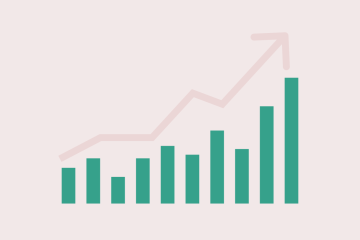
What is Euribor and how does it affect you?
The European interbank interest rate—or Euribor—impacts everything from your savings account to mortgage rates. Learn more about its impacts in this article.
5 min read
Have you heard of Euribor? If not, this interest rate may affect you more than you know—especially your savings accounts and mortgage rates. Since it’s a crucial indicator of how the economy will unfold in the future, understanding what Euribor is and how it affects you can make you more financially savvy over the long term. In this article, we’ll dive deep into what Euribor is and why it's important—for both the European economy and your personal finances.Euribor is an acronym for Euro Interbank Offered Rate, the official interest rate offered by banks in the professional interbank market. This means that it’s the interest rate from one day to one year at which banks borrow funds from each other. (If you'd like to review what interest rates are, check out our beginner's guide).There are five different Euribor types, each of them with different maturities—a finance term that means the agreed-upon date on which the interest rate is valid. In total, Euribor has 15 maturities, ranging from one week to one year. Euribor sounds like it's only important to banks—but that couldn't be further from the truth. The interest rate affects all types of consumers since they dictate the rates for private individuals too, like loans, credits, and other financial products. Why? Well, if the rate at which a bank can borrow money from other banks increases, the consumer rates must go up to cover the losses. In this way, Euribor influences all types of consumer rates in the short term—with the obvious exception of fixed interest rates of 10 or 20 years, for example, such as the ones on your mortgage when buying a house. However, if you already have a mortgage, Euribor numbers rising might increase your interest rates when renegotiating your home loan. The Euribor is calculated daily and published at 11:00 a.m. (Central Europe Time). Since banks use this interest rate to borrow funds from each other, you might expect Euribor to be a complex and automated calculation. But in fact, it’s a simple daily survey shared among participating banks. To calculate it, there are the three steps:As an economic trend, with rising inflation and talks of a recession in Europe, Euribor numbers have been steadily on the rise. This measure aims to control the speed of price increases, keeping inflation under control and steering the economy away from a harsh recession. With Euribor numbers going up, the following possibilities are becoming more likely:Before Euribor and the adoption of the euro, each European Union country had their own domestic interbank rates, such as PIBOR (France) and Fibor (Germany). With the adoption of the euro in January 1999, it became vital to have a uniform rating system. So, the EU introduced Euribor in December 1998.Given the importance that the European Union (EU) plays in the worldwide economy, Euribor does play a part in the economy of other countries, especially if they borrow money from European banks.Outside the eurozone, however, other key base rates might be relevant to calculate interest rates for individual consumers, such as the LIBOR—a number relevant especially in the United States and the United Kingdom. Interbank Offered Rates (IBORs) have been used as interest rate benchmarks in different countries, and sometimes with different values. Since the Benchmarks Regulation (BMR), which went into effect in January 2018, noticeable IBOR benchmarks needed reforming to be in line with the new regulations. This included Euribor and LIBOR, among others. Since then, Euribor has been reformed and will remain in existence until December 2025.
From saving accounts to interest rate swaps and futures, keeping an eye on Euribor numbers will help you make better financial decisions and manage your household finances. And whether you’re living on a budget or looking to improve your financial literacy, we’re here to help you bank with confidence. With N26, you’ll receive instant push notifications for every transaction, so you can track your money in real time. Plus, keep your budget under control with daily spending and withdrawal limits, right in the N26 app. If you want to get serious about saving, check out our beginner's savings guide. Then, explore our tips for how to stay on track with saving money each month. And with N26 Perks, get access to your favorite activities, services, and products—without blowing your budget. All N26 accounts include exciting offers from our partner brands, from travel to education to entertainment. You can get a great deal and still meet your savings goals—even during a recession.
What is Euribor?
Why is Euribor important?
How is the Euribor calculated?
- Collection: Every day at 10:45 a.m., participating banks must input the rate at which they are willing to borrow or lend funds for the given maturities (including one day, one month, three months, etc). External factors like supply and demand, economic growth, and inflation influence the level of the rates submitted by each bank.
- Elimination: The system collects these numbers, eliminating the highest and the lowest 15% of quotes to avoid banks giving outrageous rates to skew Euribor.
- Average calculation: Euribor is published at 11:00 a.m. The final figure is the average of all the remaining rates, rounded to three decimal places.
Current rates and rising trends
- Expensive loans: When interest rates among banks rise, they also increase for individual consumers.
- Fewer jobs: Higher interest rates aim to stabilize the economy, but can also slow its growth. Since it's more difficult for businesses to access credit, there might be fewer jobs.
- Higher savings: Savings accounts will also see their interest rates rise—consumers with a compound interest rate might see their money increase in value.
The history of Euribor
Is Euribor relevant outside the European Union?
Is Euribor being replaced?
Your Money at N26
Find similar stories
BY N26Love your bank
Related Post
These might also interest youBANKING BASICSDear Money: an exercise for rewriting your financial scriptsWhether you feel stuck, anxious, or ready to make a change, writing a letter to money can help you reflect on and reset your financial mindset.
5 min read
INVESTBear market: This is what it meansIf you think a bear market sounds rather scary, you’re already on the right track. In this article, you’ll learn what a bear market is, why it occurs, how it affects your assets and how long it lasts.
11 min read
INVESTBull markets: What they mean for your moneyNot sure what bulls have to do with the financial world? The term is mostly symbolic — but bull markets can have significant effects on your investments. Read on to learn what a bull market is.
10 min read


